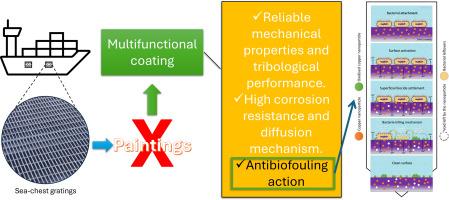Unleashing the antibiofouling potential of nano-structured ZrN-Cu coating through electricity
IF 5.3
2区 材料科学
Q1 MATERIALS SCIENCE, COATINGS & FILMS
引用次数: 0
Abstract
The world needs more environmentally friendly materials every time, especially when the application demands constant interaction with fragile habitats. The naval industry is a crucial player in a globalised economy, and the ambient impact of ships on the seas is well-known. Biofouling is one of the significant issues in this industry, and paints with biocides are used as the principal coating solution. However, those are mechanically poor, releasing heavy pollutants into the oceans. Multifunctional coatings obtained by PVD technology could help overcome this situation. The present study proposes a solution to create an advanced coating composed of zirconium nitride and copper in a specific nano-architecture. The developed coating was obtained in a hybrid magnetron co-sputtering system, employing high-power impulse and direct current power sources in a reactive atmosphere. SEM and TEM expose the morphology and the structure of the coatings. EDX, RBS, and XPS were used to assess the chemical insights of the coating. Halo and biofilm tests (with Cobetia marina) were employed to evaluate the antibiofouling action of the coating. The results showed that the activation of the coating, regardless of the used method, provoked the copper migration to the surface, being crucial to obtaining the antibacterial action (reduced bacteria adhesion and > 3 log reduction in CFU on the surface) without affecting the coating integrity (assessed by SEM), and not releasing heavy metals in a significant manner (< 2 log reduction CFU on supernatant). This opens the option of this kind of material, which is environmentally friendly, to be applied in real applications.

通过电能释放纳米结构 ZrN-Cu 涂层的抗生物污染潜力
世界每时每刻都需要更加环保的材料,尤其是当应用需要与脆弱的栖息地不断互动时。造船业在全球化经济中扮演着重要角色,而船舶对海洋环境的影响也是众所周知的。生物污损是该行业的重要问题之一,而含杀菌剂的油漆是主要的涂层解决方案。然而,这些涂料的机械性能较差,会向海洋释放大量污染物。通过 PVD 技术获得的多功能涂层有助于克服这种情况。本研究提出了一种解决方案,以特定的纳米结构制造由氮化锆和铜组成的先进涂层。所开发的涂层是在混合磁控共溅射系统中获得的,该系统在反应气氛中采用了大功率脉冲和直流电源。SEM 和 TEM 揭示了涂层的形态和结构。EDX、RBS 和 XPS 用于评估涂层的化学性能。采用光晕和生物膜试验(用 Cobetia marina)来评估涂层的抗生物污染作用。结果表明,无论使用哪种方法,涂层的活化都会促使铜迁移到表面,这对获得抗菌作用(减少细菌粘附和表面 CFU 减少 3 个对数值)至关重要,同时不会影响涂层的完整性(通过扫描电镜评估),也不会以显著的方式释放重金属(上清液中 CFU 减少 2 个对数值)。这为这种环保型材料在实际应用中的应用提供了可能。
本文章由计算机程序翻译,如有差异,请以英文原文为准。
求助全文
约1分钟内获得全文
求助全文
来源期刊

Surface & Coatings Technology
工程技术-材料科学:膜
CiteScore
10.00
自引率
11.10%
发文量
921
审稿时长
19 days
期刊介绍:
Surface and Coatings Technology is an international archival journal publishing scientific papers on significant developments in surface and interface engineering to modify and improve the surface properties of materials for protection in demanding contact conditions or aggressive environments, or for enhanced functional performance. Contributions range from original scientific articles concerned with fundamental and applied aspects of research or direct applications of metallic, inorganic, organic and composite coatings, to invited reviews of current technology in specific areas. Papers submitted to this journal are expected to be in line with the following aspects in processes, and properties/performance:
A. Processes: Physical and chemical vapour deposition techniques, thermal and plasma spraying, surface modification by directed energy techniques such as ion, electron and laser beams, thermo-chemical treatment, wet chemical and electrochemical processes such as plating, sol-gel coating, anodization, plasma electrolytic oxidation, etc., but excluding painting.
B. Properties/performance: friction performance, wear resistance (e.g., abrasion, erosion, fretting, etc), corrosion and oxidation resistance, thermal protection, diffusion resistance, hydrophilicity/hydrophobicity, and properties relevant to smart materials behaviour and enhanced multifunctional performance for environmental, energy and medical applications, but excluding device aspects.
 求助内容:
求助内容: 应助结果提醒方式:
应助结果提醒方式:


